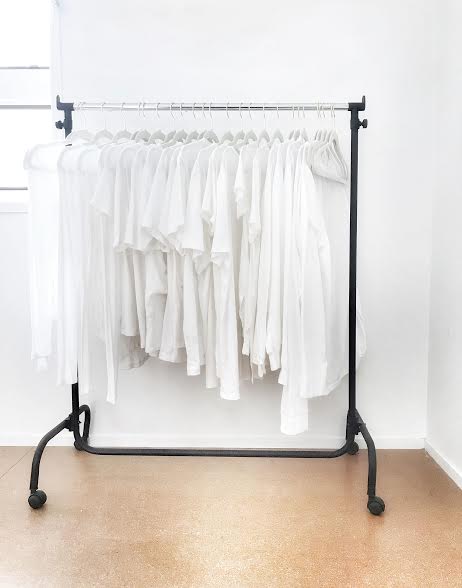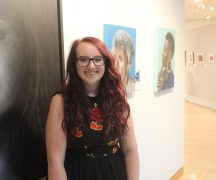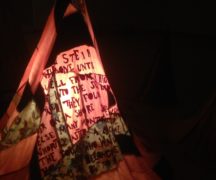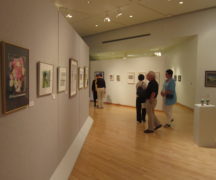By DAVID DUPONT
BG Independent News
Honey Lazar did not cry during her 35-minute-long telephone interview with BG Independent News.
That’s a first, she said. She always ends up in tears at some point when talking about the multimedia exhibit “Seen + Heard” that documents the experiences of survivors of sexual abuse and assault.
Lazar is no alone in having that reaction. Viewers cry. It’s not an easy show to experience, but an important one, the Cleveland-based photographer said.

“Seen + Heard” will open at the Bowling Green State University School of Art galleries this week. It will be open to the public Wednesday (Aug. 26), 11 a.m. to 4 p.m., Thursday, 6-8 p.m., Friday, 11 a.m. to 4 p.m., and Saturday and Sunday, 1-4 p.m. through Sept. 25.
The exhibit in Bryan Gallery has 85 intimate portraits of survivors that Lazar took while they were telling their stories. Recordings of excerpts of those stories also play. In the adjacent Red Door Gallery videos from subjects reflecting on their participation in the project are shown as well as the documentary “I Am Evidence,” about the handling of rape evidence kits, produced by Mariska Hargitay of “Law & Order: SVU” fame.
Lazar described the reaction of viewers as “compassionate discomfort.”
“Some people cry,” she said. “Some people have trouble looking at the faces because there’s an agony that explains why it’s been so difficult for people to tell their stories.”
Lazar said she uses her photography to tell long-form stories with a social justice dimension.

“Seen + Heard” started two years ago as the photographer’s response to the #metoo movement. “I wanted to think of a way to keep the conversation going because what #metoo did, in my mind, was give men and women the courage to speak.”
Lazar didn’t just want to make portraits of the survivors, but document their stories.
She emailed a flyer to her contacts explaining the project, and asked people to share the email. “Pretty instantly I started getting phone calls,” she said. Survivors’ responded: “I want to do this.”
Of the 24 people who came to her studio, she’d only known three of them previously, and she had not heard their stories of abuse in detail.
Lazar photographed each survivor using the same lighting. She wanted everyone to wear a plain white t-shirt. So, the first thing they did on entering the studio was pick a shirt.
“Then they sat down across from me and the conversation began,” Lazar recalls.
“I was a little naïve about how profoundly what each person said would affect me. I don’t think I gave it enough pre-thought.”
The profundity of their revelations, she said, “drove me to relentlessly market this exhibit. To keep this going.”
She has a commitment “to these brave people who sat across from me, who came because they wanted to inspire others to come out. This is clearly not about me. I’m just getting it out there.”
For viewers the experience is not an easy one. “But it’s important because … headlines come and go, and I really didn’t want this one to disappear,” she said.
“One unhappy byproduct of the pandemic is abuse and assault,” Lazar said. “It’s unfortunately more timely than one would think. We keep reading that in pandemic that instances of domestic abuse have been on the rise.”
The subjects have remained in contact with Lazar, anxious for any success having the project shown.
The photographer and her subjects are all grateful to gallery director Jacqueline Nathan and BGSU for providing an ideal venue for the work. Lazar said was “humbled” by having the work at the university.
Lazar said it was “a dream space” in that it allows for so much of the work to be shown while also giving viewers room to move away from it as they absorb its emotional punch.
The survivors, though, are disappointed that the restrictions that come with the pandemic have foreclosed the possibility for them to come to campus and meet face to face with people and answer students’ questions. That’s especially true for one subject who is a BGSU graduate, Lazar said.
The 164-page catalog, designed with the assistance of long-time collaborator Tanya Shteinfeld, features all 24 participants, Lazar said.
Twenty copies of the catalog are available for sale at the BGSU galleries with all the receipts benefiting The Cocoon. Lazar intends to raise money for a local organization wherever “Seen + Heard” is exhibited.
Also, playing key roles in the project were: Lauren Clune, responsible for the video and audio installation; photographerElizabeth Glorioso who helped create the lighting for the project; and Lauren Juratovac, who assisted with retouching the prints.
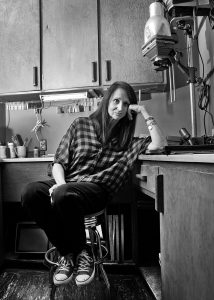
(Elizabeth Glorioso Photography)
Lazar’s roots in photography go deep, but she didn’t devote herself to it as a career until she was 40. She had been working as a social worker. “When I left my other career, I thought the only other thing I ever wanted to do in my life was pursue photography.”
Before social work, Lazar, 69, taught in an inner-city school in East Cleveland. “I loved it, and I felt to really make a difference I should be a social worker.”
Throughout this time Lazar, who got her first camera at 13, stayed active as a photographer. She participated in workshops and rented darkroom space.
Her father was a photographer and designer. He worked for the Canton Repository, as well as running an ad agency and working as a graphic designer. He photographed celebrities including Charles Lindbergh, but his true subject was his family.
He died when Lazar was 3. It was through his work that she discovered the power of photography. It “tethered” her to what was lost, she said. “I got to know my father through his photographs.”
At this point, she said, she’s been doing photography as a professional longer than she’s done anything else.
Getting the work into galleries is always a long game. She hopes the BGSU show is just the beginning for the project.
She’ll continue to push to find other venues to exhibit “Seen + Heard.” She owes it to those strangers who came to her studio and told their stories. “I’m not giving up.”

